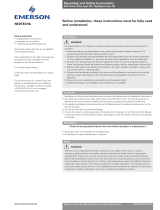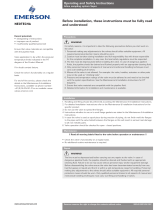Page is loading ...

KTM HINDLE ULTRA-SEAL BALL VALVES
OperatiOn, installatiOn and maintenance instructiOns
1 STORAGE/SELECTION/PROTECTION
Ultra-Seal, free floating ball valves offer
superior sealing downstream and to
atmosphere, in both reduced and full bore
designs.
Storage
When valves are to be stored for some time
before being fitted, storage should be in the
original delivery crates with any waterproof
lining and/or desiccant remaining in place.
Storage should be off the ground in a clean, dry,
indoor area. If storage is for a period exceeding
six months the desiccant bags (if supplied)
should be changed at this interval.
Selection
Ensure that the materials of construction
andpressure/temperature limits shown on
thevalve identification label, are suitable for
theprocess fluid and conditions. If in doubt,
contact the factory.
Protection
KTM Hindle ball valves are delivered
with protection according to customer’s
specification, or in accordance with the Quality
Assurance Manual, to protect the valve seats
and ball from damage. Wrapping and/or covers
should be left in place until immediately before
fitting to thepipe.
2 INSTALLATION
1. Remove protective covers from valve faces.
2. Ensure that mating flanges and gaskets
areclean and undamaged.
3. Fit the valve into pipework tightening
theflange bolts in a diagonal pattern.
NOTE
a. KTM Hindle Ultra-Seal ball valves are bi-
directional as standard and may be fitted in either
direction.
b. Installation may be carried out with stem displaced
through any angle permitted by the bolting.
c. For certain services (chlorine etc.) the valves
are designed to be uni-directional, in which case
thevalve body will be labeled ‘High pressure side’
or ‘Flow direction’.
Before installation these instructions must be fully read and understood
VCIOM-01736-EN 15/06
WARNING
For safety reasons, it is important to take the
following precautions before you start work on
the valve:
1. Personnel making any adjustments to
thevalves should utilize equipment and
clothing normally used to work with the
process where the valve is installed.
2. The line must be depressurized before
installing the valve.
3. Handling of all valves, operators and
actuators must be carried out by personnel
trained in allaspects of manual and
mechanical handling techniques.
4. Valves on liquid service, which may be
subjected to rapidly increasing temperature
in the closed position, will need a positive
means for relieving excessive cavity pressures.
Forfurther information contact KTM Hindle.
3 ROUTINE MAINTENANCE AND
OPERATIONAL SPARES
Scope
Standard Ultra-Seal ball valves both manual
and actuated. For special service designs,
typically cryogenic and fugitive emissions see
separate instructions.
Routine maintenance
No routine maintenance is required other
than periodic inspection to ensure satisfactory
operation and sealing.
Any sign of leakage from the gland packing
should be addressed immediately by tightening
the gland screws gradually and evenly. If no
further adjustment is possible the packing
should be renewed by following the instructions
in paragraph 4.1.
Spare parts
KTM Hindle valves are identified by a figure
number, which is stamped on the identification
plate, located on the valve body flange.
Thisreference should be quoted in respect of
any after sales queries, spare parts or repair
enquiries/orders.
Two year operational spares
Soft goods kits only, are recommended for
thefirst two years of operation, as follows:
• 2 PTFE seat rings
• 1 sleeve seal
• 1 set of gland packing
Our technical sales department on request
will recommend the number of kits required.
Metallic components are not normally replaced
in the initial 2-year period. Any damage to
metallic components such as stem or ball may
necessitate replacement.
Consult technical sales department for advice.
www.valves.emerson.com © 2017 Emerson. All rights reserved.

2
KTM HINDLE ULTRA-SEAL BALL VALVES
OperatiOn, installatiOn and maintenance instructiOns
4 MAINTENANCE
CAUTION
Before attempting any maintenance, ensure
the system has been fully depressurized and
if necessary, drained of any dangerous fluids.
Thevalve being removed should be operated at
least once and left in the half open position before
removal.
Before disassembling the valve ensure the valve
has been decontaminated correctly from any
harmful gasses or fluids and that it is within a safe
temperature range for handling.
Personnel making any adjustments to the valves
should utilize equipment and clothing normally
used to work with the process where the valve is
installed.
Handling of all valves, operators and actuators
must be carried out by personnel trained in all
aspects of manual and mechanical handling
techniques.
Parts identification
The illustrations on page 3 and 4 show the
parts comprising the Series 110 and Series 200
valves.
Series 200 valves (Reduced bore)
1. Complete steps 1 - 4 of the above -
Series110 (torque multiplier will be needed
for removal of sleeve on larger valves).
5. Remove stop plate.
6. Remove gland screws and gland.
7. Remove cover screws and cover.
8. Remove stem and thrust seal.
9. Remove cover gasket, gland spring, header,
chevrons and spreader.
Series 200 valves (Full bore - 2 piece ball)
1. Remove the operator (as described below).
2. Complete sections 5 - 7 as above
(Series 200 red.)
3. Pull stem out as far as possible, in order to
disengage stem from ball.
4. Remove sleeve, sleeve seal and upper
seatring.
5. Remove ball as follows:
Rotate the ball assembly inside the body,
sothat the locking ring is facing the valve
end where the sleeve has been removed.
5.1. Drive off the locking ring
(as shown in Figure 1).
5.2. Remove each half of the ball from
thevalve using ‘T-bars’. The half without
the bottom ball key must be removed
first and when re-assembling insert last
(Figure 2).
6. Remove bottom seat ring.
7. Remove stem from valve bore.
Refitting is the reversal of removal
Before refitting, ensure all sealing and metallic
surfaces in seat pockets and stem seal bores
are free from damage/corrosion. Minor defects
can be polished using abrasive cloth. If major
defects are found contact KTM Hindle’s service
department for possible repair or component
exchange.
4.2 Removal and refitting of operator
Removal
Handlever/’T’-bar
1. Remove the lever screw and lever washer.
2. Remove the handlever/’T’-bar.
Refitting is the reversal of removal.
Removal
Gearbox/actuator
1. Remove mounting bracket screws.
2. Remove mounting bracket and
gearbox/actuator.
3. Remove drive adaptor screw
(Series 110 only).
4. Remove drive adaptor.
Refitting is the reversal of removal.
4.3 Setting of travel stops on gearbox and
actuated operators
(See Figure 3 for diagram of travel stop positions)
(a) With valve out of pipeline
1. Close valve fully
2. Remove plastic indicator cover from top
ofgearbox
3. Release closed stop screw.
4. Align diamond shaped drive points parallel
to valve bore (Figure 4).
5. Tighten closed stop screw, allowing for
backlash between adaptor and stem.
6. Hold stop screw in position with Allen key
and tighten locking nut.
7. Open valve fully.
8. Visibly check that ball port is aligned
with valve bore. If incorrect follow rest of
procedure.
9. Release open stop screw.
10. Adjust ball position using handwheel until
valve is porting correctly.
11. Tighten open stop screw and lock off with
locknut.
(b) With valve in pipeline
Adopt steps 1 - 6 as above for open and closed
positions.
NOTE
For the setting of stops on actuators, see separate
instructions.
4.1 Replacement of valve components
If no further adjustment of the gland is
possible and stem leakage is still evident or
seat leakage is suspected, the valve will need
to be removed from the line in order for new
seats/seals to be fitted.
After removal of the valve, place the valve on
a workbench with the sleeve end uppermost
and adopt the following procedure to
remove/replace the seats/seals:
Removal
Series 110 valves
1.
Remove sleeve (using sleeve extraction tool),
sleeve seal and upper seat ring.
2. Remove ball.
3. Remove bottom seat ring.
4. Remove the operator (lever, gearbox,
actuator) in accordance with instructions
inparagraph 4.2.
5. Remove gland screws.
6. Remove stem nut and stop plate.
7. Remove gland spring and wiper seal.
8. Remove stem and thrust seal.
9. Remove graphite fire-seal/s.

3
90
92
91
30
95
29
78
55
93
94
1
20
75
724
25
71
3
65
8
22
23
KTM HINDLE ULTRA-SEAL BALL VALVES
OperatiOn, installatiOn and maintenance instructiOns
PARTS LIST
Item Component
1 Body
3 Sleeve
7 Ball
8 Shaft
20 Gland
22 Shaft anti-static ball
23 Shaft anti-static spring
24 Body seat
25 Sleeve seat
29 Gland spring
30 Shaft nut
55 Gland screw
65 Shaft primary seal
71 Sleeve seal
75 Shaft fire seal
78 Wiper seal
90 Handlever
91 Handlever washer
92 Handlever screw
93 Stop screw
94 Stop collar
95 Stop plate
SERIES 110

4
1
2a 2b
21
23
*
90
91
25
72
6
16
15
9
93
94
24
89
7
10
92
19
22
2c
3
4
5
5
21 20 13
KTM HINDLE ULTRA-SEAL BALL VALVES
OperatiOn, installatiOn and maintenance instructiOns
SERIES 200
PARTS LIST
Item Component
1 Body
2a Ball half
2b Ball locking ring
2c Ball key
3 Stem
4 Stem ball
5 Ball spring
6 Gland
7 Gland screws
9 Cover
10 Cover screws
13 Sleeve
15 Stop pins
16 Stop pin screws
NOTES
Model shown is stem size 1, other stem sizes have
2chevron rings.
Item Component
19 Thrust seal
20 Sleeve seal
21 Seat ring
22 Chevron ring
23 Spreader ring
24 Header ring
25 Stop plate
72 Weather seal
89 Lever or T-bar/adaptor
90 Lever screw
91 Lever washer
92 Fire seal
93 Cover gasket
94 Gland spring

5
1
2
KTM HINDLE ULTRA-SEAL BALL VALVES
OperatiOn, installatiOn and maintenance instructiOns
Split ball - disassembly
FIGURE 1
Removal of locking ring
FIGURE 2
'T'-bar fits into tapped holes on top of ball halves, to lift from body
Ball key
Gearbox - showing travel stop setting screws Seat removal
FIGURE 3
Indicates closed position stop
Indicates open position stop
Reduced bore
Valves NPS ½ - 2
Pull out
Insert
Seat
Body
Seat
Body
Extractor tool
Reduced bore valves NPS 3 - 16
Full bore valves NPS 2 - 14
FIGURE 4
Align diamond drive with valve-bore center line - as indicated

6
© 2017 Emerson. All rights reserved.
/

